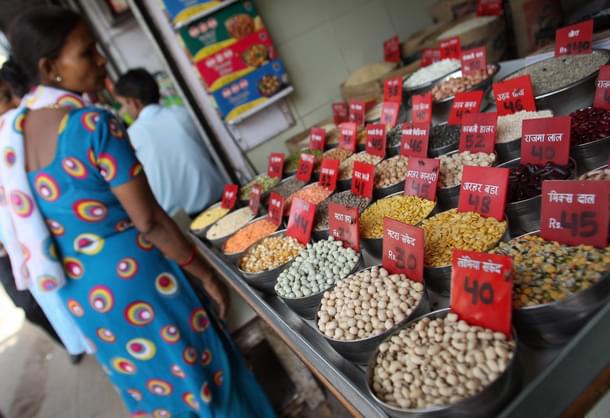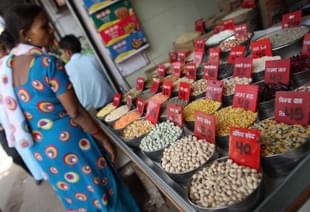Economy
As CPI Hits Five-Year Low, We Must Question Utility Of Inflation Targeting Through Monetary Policy
R Jagannathan
Jun 13, 2017, 08:46 PM | Updated 08:46 PM IST
Save & read from anywhere!
Bookmark stories for easy access on any device or the Swarajya app.


The sharp drop in retail inflation in May to 2.18 per cent from 2.99 per cent in April – a five-year low – is ample testimony to the Reserve Bank of India’s (RBI) wrong-headed notions on inflation-targeting and the government’s naive acceptance of the framework. Under the framework agreement between the central bank and the Finance Ministry reached last year, the former has to target a middle rate of 4 per cent retail inflation till 2021, and keep it within a broad band of 2-6 per cent most of the time.
At 2.18 per cent, the RBI is already close to hitting the lower end of the band, though it is fair to point out that it is only if the rate remains below 2 per cent for three consecutive quarters that monetary policy can be deemed a failure.
The problem with inflation-targeting is that it has seldom worked even in the West, where the idea was born. Its biggest failure came after the global financial crisis of 2008, which showed that monetary policy was wrongly targeted on goods and services inflation, when asset price inflation indicated that monetary policy was too loose before the crisis. But even after it was loosened further post-2008, there was no impact on inflation, though theory tells us that zero-cost money should impact retail inflation.
The failure of inflation targeting was announced with great fanfare by Jeffrey Frankel, Professor of Economics at the Harvard Kennedy School in 2012, with this introduction: “It is with regret that we announce the death of inflation targeting. The monetary regime, known affectionately as “IT” to its friends, evidently passed away in September 2009. That the demise of IT has not been officially announced until now testifies to the esteem in which it was widely held, its usefulness as a figurehead for central banks, and fears that there might be no good candidates to assume its position as preferred anchor for monetary policy.”
In India, inflation-targeting makes even less sense, as our inflation is determined less by the price of money than by regular supply-side shocks, especially in food and fuel.
The benign nature of retail inflation over the last three years has almost nothing to do with how tight monetary policy was (or is), but with good fortune (on global oil prices) and good price and supply management in food by the NDA regime. So for the RBI to postpone rate cuts on the plea that food inflation may flare up in the second half of the year is a bit rich, since, as the Chief Economic Adviser pointed out the other day, it has consistently overestimated inflation.
Three points are worth making.
First, inflation-targeting, if at all it is attempted, must focus on supply side issues, which means the government’s responsibilities in this area, including taxation, must be part of the deal. In India, the fiscal authorities will always have a larger role to play in food managing inflation.
Second, the RBI’s role in inflation-targeting should be focused on core inflation – that is non-food, non-fuel inflation.
Third, it may be best to abandon inflation-targeting altogether and focus on a broader set of objectives, which could include inflation, growth, money supply, etc. Nothing is gained by giving the RBI the wrong target to chase. The government has only itself to blame when the RBI goes terribly wrong on its inflation targets because that is what it has been asked to focus on. In India, given our past history, where politicians get jumpy whenever even one item of common consumption shows a price spike, the central bank tends to worry more about the possibility of runaway inflation than persistent disinflation.
In India, retail inflation is about politically balancing the interests of consumers and producers, and so the risk of overshoots in one direction or the other is real – and not something monetary policy can do anything about. In fact, monetary policy can do damage – as it is now doing – by keeping rates too high.
A look at the Consumer Prices Index (CPI) will tell you why. The CPI is 46 per cent driven by food and beverages inflation, and 7 per cent by fuel. In other words, well over half of inflation trajectory is determined by products on which government policies (on minimum support prices, on input subsidies, product taxes, etc) determine consumer prices.
Take food. With MSPs, power, fertiliser and seed price subsidies, not to speak of import and export duties imposed at random depending on internal supply situations, almost all elements of food pricing are in government hands. So even if the monsoon plays truant or is bountiful, final prices depend on what the government does, and not what the price of money is.
The sharp drop in CPI in May has been led by negative food inflation (-1.05 per cent), due to the glut in dal and other agri-produce, which explains why farmers are up in arms.
Or consider fuel. Pump prices of petrol are three times as much as the per litre cost of crude, and more than twice as much as the cost of crude plus refining plus dealer margins. In short, more than half your pump price is accounted for by state and central taxes.
The implication is this: no matter where the crude price is, changes in taxes can keep fuel prices stable by adjustments in rates. When prices were falling, the NDA government almost regularly kept raising excise on petrol and diesel, thus blunting what could have been an even greater fall in CPI between October 2014 and now.
The question to ask thus is whether RBI should really be using monetary policy while dealing with food and fuel inflation, or leave this job to the government and the fiscal side? Of course, if the government is not doing its bit, the RBI must raise rates to fire a warning shot across the bow.
When prices are not market-determined, inflation-targeting should be more of a fiscal responsibility than a monetary one.
It is time to abandon inflation-targeting as a part of monetary responsibility. It will not work. We are setting the RBI up for failure – unless that is the whole purpose.
(This is a corrected version of an earlier article which overstated the weights of food and beverages and fuel. The earlier figures related to weightage for the rural index, and not the combined one)
Jagannathan is former Editorial Director, Swarajya. He tweets at @TheJaggi.





